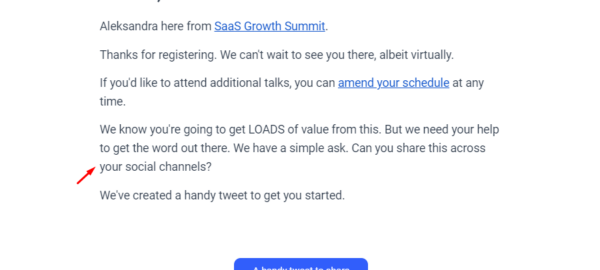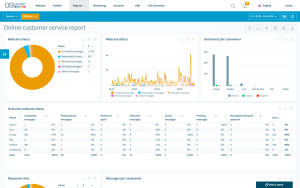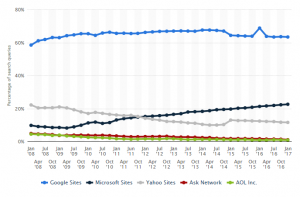2020 brought an unparalleled increase in online versus offline events, with some platforms reporting 1000% growths. While the events industry initially took a blow, most organizers pivoted and moved their conferences, summits, or meet-ups online.
And the rewards appeared quite quickly. Virtual events typically have better ROI than in-person ones. The reason for this is quite simple: it’s much cheaper to organize an online event than an in-person one. You can cross travel, venue, and hospitality off your budget list and invest that money into advertising or simply pocket it.
Affordable planning doesn’t make a virtual summit successful, though. Only 53% of event professionals consider themselves savvy with virtual event technology.
Luckily, organizing a virtual summit from scratch is a skill that can be mastered. And you may even be able to score heavyweights like Rand Fishkin or Nathan Latka as your speaker. How? Read on!
Here are the seven pillars of successful online events:

- Alexandra_Koch / Pixabay
#1 Setting Goals for Your Virtual Summit
The first pillar of any successful endeavor is goal setting. If you don’t have clear, measurable goals, then how can you learn if the event was successful or not?
Start with the primary goal. Do you want your summit to:
- Generate leads?
- Establish you/your company as a thought leader in your field?
- Help you build lasting partnerships?
- Generate ticket sales?
All of these are excellent goals that are reasonably easy to meet. While you can focus on more than one, it’s important to avoid trying to check all the boxes — you may end up not meeting any of them.
So, focus on what or two major goals and build your summit around them.
To make it easier to evaluate your success after the summit, add some quantifiable/measurable KPIs:
- Number of attendees (paid/free)
- Number of speakers
- Total leads generated
- Total leads converted
#2 Should You Opt for a Live Summit or for a Pre-Recorded One?
This is one of the biggest dilemmas virtual summit organizers have. There is no one-size-fits-all and both options have their pros and cons. Let’s take a quick look at them.
Live summits come with one major benefit: the attendees get to attend something in real-time. This makes the summit feel more authentic. Plus, during a live conference, the attendees can also ask questions, the speakers can answer them. In turn, this increases engagement and makes the whole event more interesting for everyone.
On the other hand, live summits can be nerve-wracking. Even more, during a live event, technical glitches are harder to solve and they can dramatically impact user experience.
You need to have a cool head and be ready to battle with ANYTHING that comes your way. What can that be? Anything from people not being able to login to speakers not showing up for their session (yep, happened twice to me in 1 day).
If you opt for a pre-recorded summit, you can easily weed out technical issues and the viewing experience will be seamless. Furthermore, it’s easier to control speaking times and stick to the initial schedule. Lastly, for some attendees, it might be more comfortable to watch a pre-recorded summit because they can do it in their own time and at their own convenience. This is a very important point, especially if you’re targeting people in different time zones.
However, a pre-recorded virtual summit doesn’t allow the organizing party to connect with the speakers on a deeper level. All of these speakers may be your potential partners in the near future.
#3 Should Your Summit Be Free or Paid?
A paid summit comes with the obvious benefit of bringing in revenue. Another major selling point here is the fact that attendees have “buy-in” — they paid for the ticket, so they are invested and are more likely to attend it.
On the other hand, a paid virtual summit will naturally have fewer people to register and, thus, fewer leads. If generating leads is a primary goal for you, you may consider the free option.
Free virtual summits will have more people registering for them but not all will attend. However, you can still use the contact information of the people who registered and add them to your sales funnel.
More importantly, you don’t have to choose strictly between A and B. You can also go for the hybrid or the “freemium” option: the virtual summit is free to attend when it’s live, but people who want to watch the recording have to pay a fee.
#4 How to Find Speakers for Your Virtual Summit?
The “line-up” of your summit is the detail that can make or break the entire event. A lot of summit organizers start out with a list of people they would like to invite as speakers and only then focus on the topic(s) of the event.
This approach can lead to an unfocused event that will attract far fewer participants than it could have. A clear outline of the event and a focus topic will make targeting participants and converting them far easier. Even better, it will make finding the right speakers and getting them to say “yes” a walk in the park. With a clear topic “in hand”, it will be easier to research potential speakers and find out who has the expertise you need for your summit’s audience.
Once you have the topic and the outline of your event in mind, it’s time to start reaching out to potential speakers. I recommend doing this two to three months in advance to give everyone time to prepare.
Start out with a couple of “small” speakers. As soon as you have buy-in from them, it will be easier to approach the industry thought leaders, who typically want to see that an event already has other speakers before agreeing to participate in it.
Not sure how to reach thought leaders that would make great headliners? Leverage your network! Talk to some of the speakers who already agreed to participate and ask them if they can open some doors for you.
When you do get to pitch an industry influencer, make sure you have a value proposition for them. Explain how speaking at your summit will be beneficial to them in the short and long run. Don’t ask for a big commitment. Request to host just a Q&A session with them first which won’t require any preparation work.
You can mention:
- The lead generation potential (which means that you will share your lead list with them)
- Your advertising budget that will put their face in front of a lot of people
- A speaking fee (some summit organizers pay the speakers, while others do the opposite: charge a fee for everyone who wants to get in front of the event’s audience)
So, here’s how I got Rand Fishkin to agree to speak at the summit for free. Are you ready? Here it goes…
I asked.
Yes, that’s it. One important tip: make it as easy as possible for them to agree. Ask for a low commitment, like a quick Q&A that won’t require prep time on their part and of course share what exposure you’ll be able to get them if it’s anything north of 1000+ attendees.

Got the final list of speakers? Excellent! It’s now time to agree on topics for each presentation and make sure that no two speakers choose the very same topic.
Equally important, it’s time to leverage your speakers’ audience. Get them to promote the summit — it will be beneficial for them, too, to have a bigger audience!
#5 How to Choose a Platform for Your Virtual Summit
The platform that will host your virtual summit is a decision that you don’t have to make right away. Not because it’s less important — quite the opposite. You need to know more about your summit (estimated number of attendees, speakers, schedule, live or pre-recorded, and so on) so you can make the best decision.
Some of the most popular virtual summit platforms are:
- Zoom is ideal for pre-recorded summits. You can use the free version or upgrade to the paid one so you can record in HD format.
- HeySummit is super-easy to use and it comes with a major benefit: integrated landing page builder. You can use it for both pre-recorded and live summits and it also comes with useful features like self-service speaker dashboards and detailed event analytics. Important point: if you want to hold a live summit, you have to integrate HeySummit with Zoom.
- AirMeet is great for live summits. It has user-friendly features like “raise hand” (allows the attendees to ask questions), polls, public and private chats, emoji reactions, and many others.
You can always mix and match. For SaaS Growth Summit, I used both AirMeet and HeySummit, since AirMeet doesn’t have a landing page builder of its own.
#6 Meet, Greet, and Delight Your Attendees
The first thing you want to focus on after choosing the platform is the registration process. My key tip here is: keep it simple! Make the whole registration a breeze so you don’t have a lot of people dropping out halfway through the process.
Make it intuitive — start with a clear and visible CTA button that people can click on to get started. On the registration form, only add the fields that are absolutely necessary to process their request. Forget about physical address and, if it’s not very relevant to you, the company name and industry.
Don’t forget to set up a few automated email sequences: a thank you email, the participant’s schedule, and a few reminders about the start date (the last one should be on the very day of the summit).
Even if the summit is over, it doesn’t mean that your communication with the attendees should also be over. Send them a “thank you for joining email”, followed by any additional materials: slide decks, replay links, additional reading materials recommended by the speakers, and so on.
#7 How to Promote Your Virtual Summit
This is a somewhat sensitive topic because most people think you need a huge budget to promote a summit. In my experience, less is more when it comes to advertising.
Of course, you want to reach as many people as possible. But the one thing that helps with keeping your budget under control and with increasing your conversion rate is zeroing in on your audience.
Build a detailed ideal persona:
- Who is your ideal attendee?
- What is their job title?
- What are their pain points that the summit can solve?
- Where do they hang out online?
- What media do they trust (communities, blogs, influencers)?
This is a great start to keep you from spending money on advertising methods that won’t work. For instance, if your audience hangs out on LinkedIn, why waste money on Facebook Ads? If they don’t respond to traditional PPC ads, why not invest in influencer campaigns or guest posts on the websites they love?
A great and cost-effective way to promote your summit is through the networks of the speakers. Talk to them openly and tell them how much it would help both of you if they emailed their list and tweeted about the event frequently.
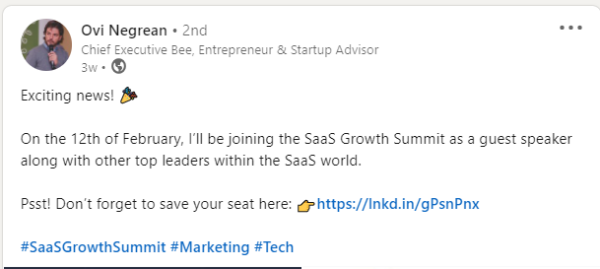
Lastly, think about catchy ways to turn your attendees into brand ambassadors. A social share button after registration can work wonders. Especially if you phrase the CTA in a way that implies that attending is a badge of honor they should be proud of. Additionally, you can offer bulk discounts: refer us to a friend and you both get 20% off. Or register your entire team (a minimum of four people) and get a 30% discount.
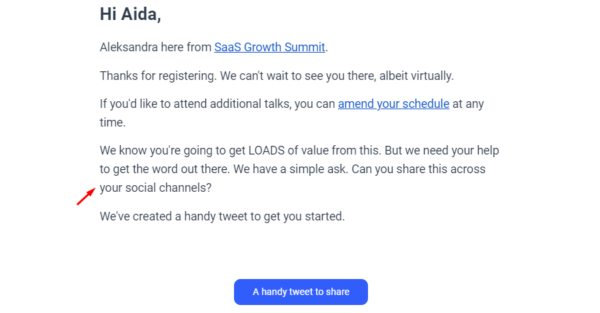
Conclusion
Your first virtual summit can feel intimidating. This is why I recommend you build it block by block. Follow the framework above to create a solid foundation and then all the other pieces will fall into place.
Business & Finance Articles on Business 2 Community
(40)
